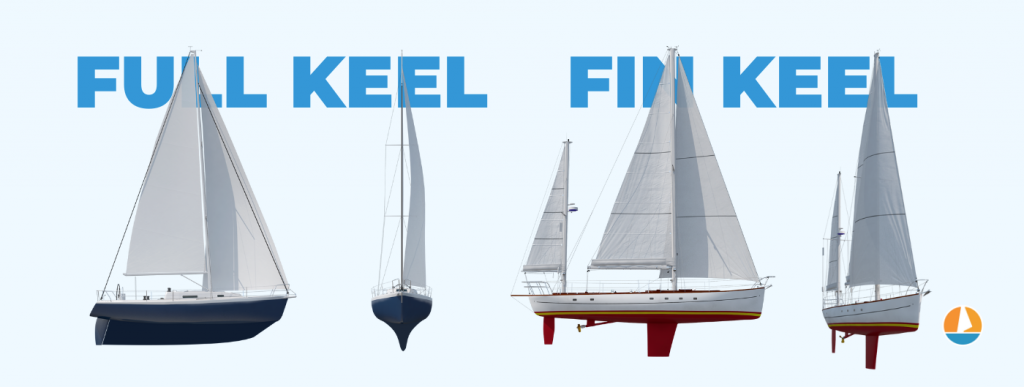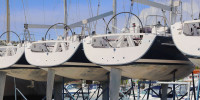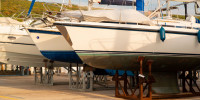Fin Keel vs Full Keel: Pros and Cons & When to Choose Which
When picking a boat, what's under the water can be more important than what you can see when she's floating on her lines. The keel is a major factor in how a boat sails and how you use it. Modern improvements in yacht design favor the fin keel, with very few full keels put on new boats in today's market.
So why would you choose a full keel instead of a fin keel? Are there distinct advantages to one style or another?
If you're looking for an older boat with high stability, sea kindliness, directional stability, and a shallow draft, a full keel can be a good choice. For more sail performance and easier handling along with many other benefits, a fin keel will be your best choice.
To make this decision, you need to understand the advantages of the keel types, and how they will affect your sailing. In this article we'll give you the disadvantages of the keel designs and help you to make a good choice.

On this page:
Keels Stabilize a Sailboat and Improve Tracking
The primary function of a keel is to stabilize a sailboat against the forces on the sails. A keel does this with weight acting as a counterpoise (or lever) against the rig, and with resistance to pushing against the water. The forces on the sails push against the the keel, and the sum of these forces moves the boat through the water against the wind.
Besides pushing back against the wind, the keel gives a hull resistance to sideslip; it helps the boat track forward through the water, and can make a boat more or less stable and responsive to changes in the wind. For a more in-depth discussion on keel function, check out What Is a Sailboat Keel and How Does it Work?
While a keel allows a boat to sail against the wind, it also creates drag under water. The more surface area that’s in contact with the water, the more drag. The shape of the keel and the amount of wetted surface area will dramatically affect a boat's speed.
Full Keels Provide the Most Stability and Comfort
The full keel is the oldest style of keel, used since the earliest sailboats. A full keel is integral to the hull and runs the entire length of the under-body of the boat. The rudder is hung at the end of the keel if it's not transom mounted.
Most "full keel" boats from recent decades are modifications of the centuries-old full keel. They are often a modified full keel like you'd find on boats like the Island Packet, where the keel runs about 3/4 of the length of the underwater area of the boat rather than the full length. For our purposes, these modified full keels offer most of the same benefits and drawbacks as a "proper" full keel.
Why Would You Want a Full Keel?
In our related article 5 Surprising Advantages of a Full Keel Sailboat, we learned a full keel:
- Provides better tracking with that long keel in the water.
- Is integral to the hull construction, giving it more strength to survive groundings.
- Gives better rudder and propeller protection because they're behind the keel with no gap.
- Is more comfortable because of the increased stability from the large keel.
- Has less draft than fin keels.
As a stable cruising platform for crossing oceans and exploring, it's hard to argue against the full keel except based on speed and sailing performance. Full keels make for tough, sturdy and sea-kindly boats that are comfortable in terrible conditions and at anchor.
Why would you NOT want a full keel?
There are a few downsides to the full keel, though.
- They have much more wetted surface area. This increased drag slows the boat a lot.
- All that good tracking? It makes them more difficult to maneuver in close quarters.
- They don't go to windward as well as modern keel designs.
- Full keel boats tend to have less interior volume.
Modern keel designs have shown up the full keel on sailing performance. If you plan to race your boat, a full keel is a terrible choice. Many cruisers still prefer the better upwind and straight-line performance of fin-type keels.

Fin Keels Provide the Best Performance
The fin keel isn't as modern as you might think. Pioneering yacht designer Nathanael Herreshoff built one of the first successful fin keeled boats in 1892, though it wasn't until the 1950s and 60s that fin keels entered more popular use.
Why would you want a fin keel?
Performance is the top reason for a fin keel. Boats with fin keels sail much faster, point closer to the wind, and outperform full-keeled boats on every point of sail. Fin keeled boats are not only faster, but they handle more easily under power, they are more agile tacking and turning, and usually have more interior volume for gear and living.
Since a keel is, in essence, a lever, the forces used to counteract the sails and rig can be applied with a variety of weights and lengths to get the same effect. A weight eight feet under the waterline can give just as much righting moment to the boat as a much heavier weight three feet below it.
Righting moment refers to the force that returns a heeled or tipped boat back to vertical. A boat's center of buoyancy (COB) changes as it tips, when it's out of line with the center of gravity (COG) there's a righting force trying to right the boat and line the COG up with the COB again. The keel increases this force and helps keep the boat stable and upright.
Keeping a safe righting moment while decreasing drag from wetted surface area and reducing weight allows for much better sailing speeds.
Performance isn't just about winning races. If your boat can cover 160 or 180 miles in a day instead of 120, you have more options avoiding big weather systems. You'll need to carry less food and water, and shorter passages mean fewer chances to break things, less wear and tear on the boat and the crew, and you'll hit fewer storms.
Why wouldn't you want a fin keel?
Full keel proponents make two principal arguments against fin keels - comfort and safety. We'll get to safety in a moment, but comfort is a legitimate concern offshore. An uncomfortable crew tires quickly, is prone to seasickness, and can make mistakes.
Fin keels don't make good cruisers
Fin keeled boats maintain stability and righting moment with a variety of shapes and appendages, and how these shapes affect the boat's stability over a range of forces and conditions can affect comfort.
Racers will tell you that a "tender" boat will power up quickly and heel hard in less wind than a "stiff" boat. Full keels are very stiff and don't heel easily, but some keel boats are quite tender and will heel early and often. These boats require more and earlier reefing to stay flat, or the crew spends a lot of time on a tipping boat. Racers put crew members up to sit on the windward rail to stiffen up a tender boat when the breeze picks up, but this isn't an option for a cruising couple or small crew on a long passage.
While not endemic to all fin keeled boats, more tender boats don't make good cruising vessels. Builders of offshore boats with fin keels still aim for good stability and comfort, but you're more likely to find a fin-keeled racer/cruiser a lot less comfortable on a short handed passage.
Not all fin keels are suitable for offshore
Many safety concerns about fin-keeled boats are overstated, and come more from myth and hearsay than fact. I've been told that I should "never go offshore in anything but a full keel." This is a nonsensical position; blue water sailors (including this one) have been crossing oceans safely for years on fin-keeled boats. But that doesn't mean any fin-keeled boat is suitable for offshore sailing.
The primary safety concerns with fin keeled boats include:
- External ballast. Unlike a full-keeled boat, most fin keels are external to the hull, so they need to be bolted on. There is a risk that an external keel could fall off after a hard grounding or other damage to the keel bolts or structure.
- Deep drafts can lead to groundings. This relates to the external ballast concern - a grounding with an external keel can cause more damage or losing the keel.
Boat designers and builders are aware of these concerns, and hull/keel joints are among the strongest part of a boat construction. Keels and ballast "just falling off" without a prior grounding or other uncorrected damage isn't really a concern.
Which Is Best for You?
Like every question about boat choice, the answer mostly comes down to you and your preferences, and how you plan to use the boat.
Are you planning to sail offshore or do extensive coastal gunkholing and performance isn't a concern? A full-keeled boat could be a perfect choice. If you're concerned about comfort offshore or you or your crewmates are prone to seasickness, they're more stable and sea kindly.
If you're a weekender or a racer, you'll probably want a faster fin-keeled boat. And if you're a cruiser who wants to cover more ocean on faster passages, some form of modified fin keel will be your best choice.
Did you find the answer to your specific question?
👍 17 👎 1




Comments
Steve Mueller
Other than Island Packet, Who else manufacturers full-keeled boats. Does Kraken come close to a full keel?
Leave a comment